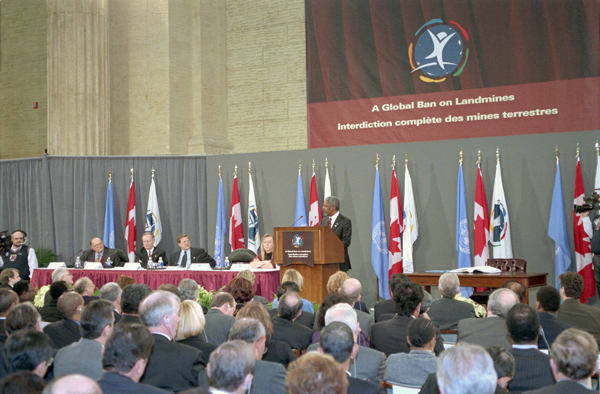
After no progress was made at the 1996 UN Weapons Convention, Canada took the lead and invited participants to a conference in Ottawa in October of the same year. Foreign Minister Lloyd Axworthy called for a treaty to be negotiated within a year – an unusually ambitious schedule that was ultimately met through an unusual multilateral process.
The “Ottawa Convention”
September 18, 1997
“Convention on the Prohibition of the Use, Stockpiling, Production and Transfer of Anti-Personnel Mines and Their Destruction”
On September 18, 1997, the Ottawa Convention was adopted, an international agreement that is considered one of the most significant humanitarian advances of the late 20th century. Anti-personnel mines, which were used in numerous conflicts over decades, claimed countless civilian victims, often long after the fighting had ended. With the convention, the signatory states committed themselves to completely banning the use, stockpiling, production, and transfer of these weapons. In addition, the agreement stipulates that existing mines must be systematically cleared and victims supported. Since the treaty came into force, over 40 million mines have been destroyed and large areas of land cleared, which can now be used safely again.
What was particularly remarkable was not only the content, but also the way it was achieved: at a time when traditional disarmament negotiations seemed to have reached an impasse, a coalition of smaller states and international NGOs succeeded in creating a new negotiating space. The treaty was the result of an unusual and unique multilateral process outside traditional UN structures, known as the Ottawa Process. This was characterized by close partnership between medium-sized and smaller governments, international organizations, and civil society.
165 countries have now ratified the agreement, and the Ottawa Convention is considered the most widely supported treaty concerning a specific weapon. Major powers such as the US, Russia, and China have not signed the treaty.
The Ottawa Convention in light of the Harvard Circle
Making the common goal visible
The pillars of the campaign – banning the production, use, and stockpiling of mines, clearing existing mines, and supporting survivors – created a clear set of guidelines. This humanitarian objective became the common ground that united the interests of the negotiators.
Building trust, even despite initial skepticism
Despite initial reservations, informal meetings, personal encounters, and the active role of NGOs created a basis for dialogue. Trust did not grow overnight, but through continuous dialogue.
Interests instead of positions
Powers such as the US, Russia, and China held fast to mines, while smaller and medium-sized states such as Canada, Norway, and South Africa, together with former mine producers and users such as Italy and Mozambique, pushed for a ban. By identifying security policy interests, an alliance was forged between those states that placed greater emphasis on ending humanitarian suffering than on strategic positions.
Creative ways to reach agreement
Negotiations did not take place within the framework of the United Nations, but rather in an “opt-in” process: countries had to accept the treaty text, which was based on an Austrian draft, before the actual conference in Oslo. Decisions were made by vote, not by consensus. This unconventional method prevented deadlocks and resulted in a strong, clear treaty text.
Setting objective standards
Success was measured not by the minimum compromise, but by clear standards: destruction of mines within four years, clearance of affected areas, and regular reports. These criteria made progress measurable and lent credibility to the convention.
Flexibility in dealing with reservations
Not all countries were immediately willing to sign up. Despite the absence of major military powers, the Ottawa Convention was adopted with over 120 signatories. The openness to later accessions ensured the initiative’s long-term legitimacy and reach. To date, 164 countries have signed the agreement, representing more than 80 percent of all countries worldwide.
Sources & Further information
- https://disarmament.unoda.org/en/our-work/conventional-arms/legal-instruments/anti-personnel-landmines-convention
- https://www.fedlex.admin.ch/eli/cc/2003/431/de
- https://www.armscontrol.org/act/1997-09/arms-control-today/ottawa-landmine-treaty
- https://www.handicap-international.de/de/landminen/kampagne#:~:text=Vertrag%20zum%20Verbot%20von%20Landminen,zudem%20zu%20Entminung%20und%20Opferhilfe
- Silvela, A. V. (2024). Unorthodox and Historic: The Ottawa Process and the Mine Ban Treaty. 25 Years of a Success Story of Multilateralism. Comillas Journal of International Relations, (29), 68-89